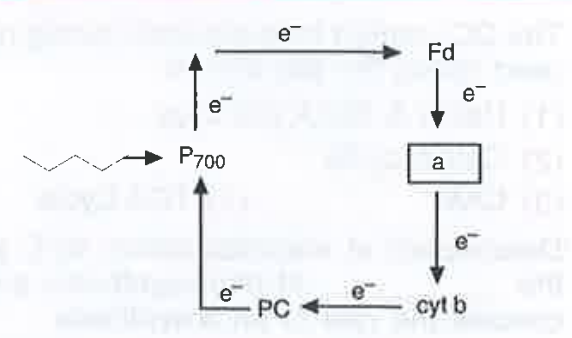What kind of Photophosphorylation takes place in P680 (PS II)?
Step-by-Step Solution:
1. Understanding Photophosphorylation:
- Photophosphorylation is the process of adding a phosphate group to ADP to form ATP, using energy derived from light. The term "photo" refers to light, and "phosphorylation" refers to the addition of a phosphate group.
2. Identifying the Type of Photophosphorylation:
- There are two main types of photophosphorylation that occur during photosynthesis: cyclic and non-cyclic photophosphorylation.
3. Role of P680 in Photosystem II:
- P680 is the primary pigment in Photosystem II (PS II). When light is absorbed by P680, it excites electrons, which are then transferred to an electron transport chain.
4. Non-Cyclic Photophosphorylation:
- In non-cyclic photophosphorylation, the excited electrons from P680 do not return to P680. Instead, they move through the electron transport chain, ultimately leading to the production of NADPH and ATP. This process involves the movement of electrons in a linear fashion.
5. Conclusion:
- Therefore, the type of photophosphorylation that takes place in P680 of Photosystem II is non-cyclic photophosphorylation.
- Photophosphorylation is the process of adding a phosphate group to ADP to form ATP, using energy derived from light. The term "photo" refers to light, and "phosphorylation" refers to the addition of a phosphate group.
- There are two main types of photophosphorylation that occur during photosynthesis: cyclic and non-cyclic photophosphorylation.
- P680 is the primary pigment in Photosystem II (PS II). When light is absorbed by P680, it excites electrons, which are then transferred to an electron transport chain.
- In non-cyclic photophosphorylation, the excited electrons from P680 do not return to P680. Instead, they move through the electron transport chain, ultimately leading to the production of NADPH and ATP. This process involves the movement of electrons in a linear fashion.
- Therefore, the type of photophosphorylation that takes place in P680 of Photosystem II is non-cyclic photophosphorylation.
Topper's Solved these Questions
- PHOTOSYNTHESIS IN HIGHER PLANTS BOOK - ICSECHAPTER - PHOTOSYNTHESIS IN HIGHER PLANTS EXERCISE - REVIEW QUESTIONS (SHORT ANSWER TYPE QUESTIONS)
19 Videos
- PHOTOSYNTHESIS IN HIGHER PLANTS BOOK - ICSECHAPTER - PHOTOSYNTHESIS IN HIGHER PLANTS EXERCISE - REVIEW QUESTIONS (LONG ANSWER TYPE QUESTIONS)
11 Videos
- PHOTOSYNTHESIS IN HIGHER PLANTS BOOK - ICSECHAPTER - PHOTOSYNTHESIS IN HIGHER PLANTS EXERCISE - REVIEW QUESTIONS (DIFFERENTIATE BETWEEN THE FOLLOWING)
7 Videos
- PHOTOMORPHOGENESIS IN PLANTSBOOK - ICSECHAPTER - PHOTOMORPHOGENESIS IN PLANTSEXERCISE - REVIEW QUESTIONS (LONG ANSWER TYPE QUESTIONS)
6 Videos
- PLANT GROWTH AND DEVELOPMENTBOOK - ICSECHAPTER - PLANT GROWTH AND DEVELOPMENTEXERCISE - NCERT EXERCISES WITH ANSWERS (DIFFERENTIATE BETWEEN)
11 Videos
Similar Questions
Photosynthesis cannot continue for long if during light reaction . Only cyclic Photophosphorylation takes place. This is because

View SolutionName the following :
The structure where photophosphorylation takes place.
View SolutionName the following :
The structure where photophosphorylation takes place.
View Solutionwhich molecule in non-cyclic photophsphorylation donates electron to PS II ?
View SolutionA: For every CO2 molecule entering C3 cycle , three molecules of ATP and two NADPH are required .
R: Cyclic photophosphorylation takes place to meet the difference in number of ATP.
View SolutionWhich kind of respiration takes place in frog, if it is inside water?
View SolutionIn the chart of photophosphorylation, what does 'a' represent

View SolutionName the kinds of cells found in the place Brain
View SolutionIn non-cyclic photophosphorylation, PS I is reduced by
View SolutionCyclic photophosphorylation is carried out by
(a) P S I only
(b) P S II only
(c) Both a and b
(d) Photolysis and P S II
View Solution
